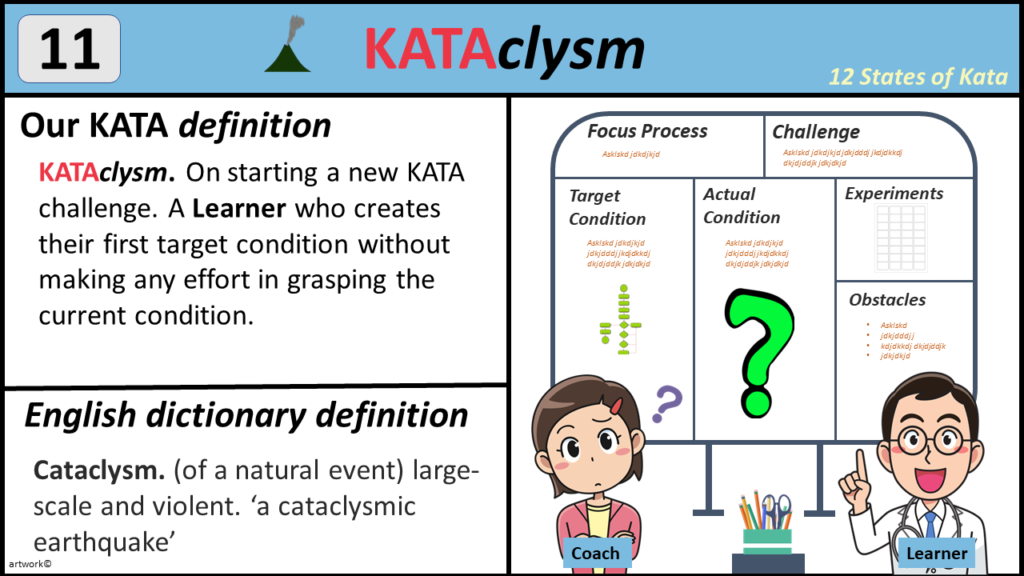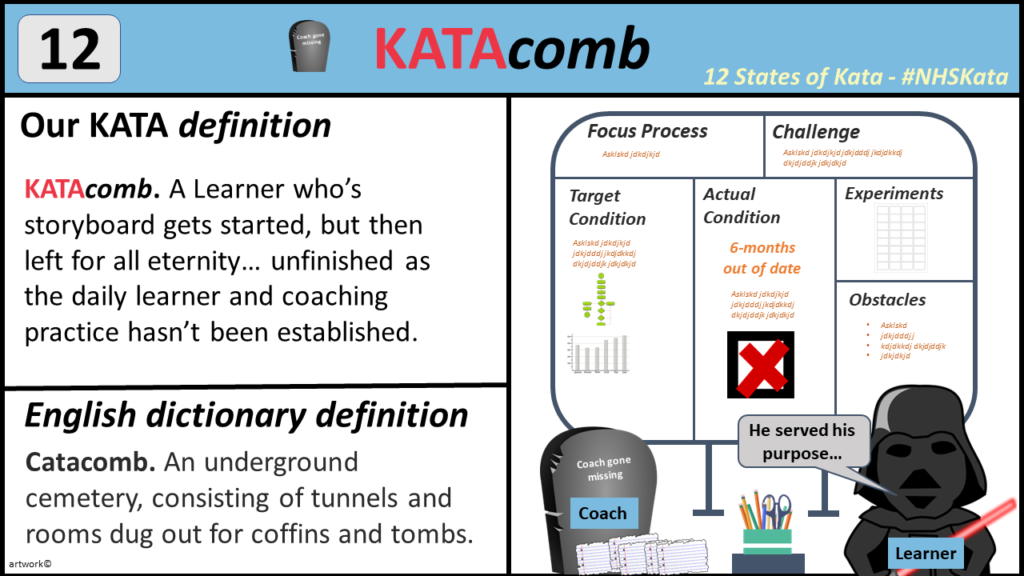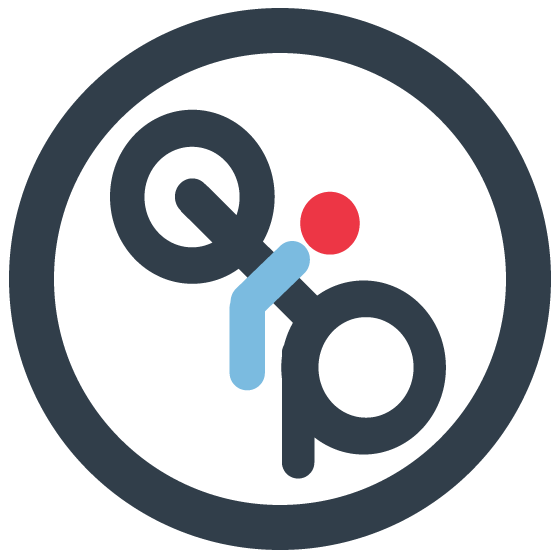
The Twelve States of Kata
As a Kata coach. I have had the opportunity to immerse myself both as a learner, a coach and sometimes a second coach. Today is not about teaching Kata, but just some personal reflections of the whole Kata process. I will be focusing on patterns of behaviours between the learner and coach which could impact on the success of Improvement Kata. In the twelve states of Kata, I have done a bit of a play on words by using ‘Kata’ each time as the first part of the word to describe the outcome or behaviour (very loosely!). I hope you will find this blog informative as a new starter to Kata and perhaps even humorous if you have been doing Kata for a while!
If you want to know more about Kata, there are plenty of resources on the web such as this one. https://www.lean.org/lexicon-terms/kata/ . I would recommend reading Mike Rother’s book on Toyota Kata too.

1. KATAbolism – A good thing
One of the key design features of a Kata Board is the way it enable the coach and learner to breakdown a potentially large project into smaller bite-size chunks for the learner and coach.
This is through the initial challenge statement, broken down into more specific focus processes. Then aligning each focus process into smaller target condition statements to work towards.
However, later on you will notice another dynamic with the relationships between each target condition, the obstacles that need to be over come through the experiments using PDSA cycles.

2. KATApult – A good thing
The role of the coach as to develop quickly the skills of a Kata learner. The coach enables what has been described in the Katabolism section to happen. They develop the learner’s ‘growth mindset’. Allowing learners to feel comfortable with uncertainty. Just as important is the role of the Coach to keep the learner on track. Particularly in ensuring the Target condition is SMART and in particular, achievable, within a maximum of 2-3 weeks to achieve teh target conidition.
The coach also helps ensure obstacles are related to the current target condition.
Finally, the actual condition is regularly updated to reflect the attempted improvements.

2. KATAlyst – A good thing
The coach acts as a guide to the learner, not just by systematically supporting the removal of obstacles and working towards the target condition, but also by celebrating the process in how this was achieved. The daily practice of Starter Kata with coach and learner improvement kata cycles enables a scientific approach to improvement. Similarly a well versed ‘second coach’ in Kata may pop by and observe the whole coacher-learner improvement kata cycle as a fresh set of eyes for the coach. The second coach is a formal role in developing the skills of the coach. Yes, a second Coach also a card with a set of questions to ask the coach (please remember, the learner is not present for the feedback to the coach).

4. KATAlog– A good thing
There are some good habits that develop as a Kata learner if fully engaged in the process. One of them is to keep a record of all their personal reflections of how they felt the improvement kata cycle went with the learner. But also to record later what the reflections from the feedback from the second coach too. In my experience, it is difficult to develop the skills as a learner if you do not take time to reflect. These reflections should be written down or kept on an electronic log. These logs should be reviewed often to monitor your own development as a kata learner. The log can also sometimes be used for evidence for their Kata improvement journey.

5. KATApiler– A good thing
Similar to the principles of keeping a log of your reflections. A learner should also keep a record of the old paper copies of target conditions, actual conditions, experiment PDSA logs and Obstacle sheets, Preferably in a plastic wallet or filing cabinet. They can go missing quite easily! As you develop, you can sometimes go back to them to see how you have progressed. You may find yourself saying to yourself “Wow, that target condition is so vague”, “I really didn’t update my current condition much” or “that wasn’t much of an experiment. I already knew the answer to this'”.

6. KATArrh– A not so good thing
Seen this a couple of times. Often from an experienced leader with the persona of “I’ve seen this all before, nothing new here”. They have an air of misplaced confidence. They are well practiced in their leadership style and it seems to work well for them. Although the coach attended all the appropriate training. They didn’t necessarily engage, take time to reflect and establish new daily practices and behaviours. i.e. the need to relearn how to ride a bike.
This is characterised by their lack of engagement with the basics, such as not reading out the Kata Card Questions in front of the learner and randomly moving around the Kata board in an unstructured fashion. This makes it very challenging for a new learner. Who has prepared diligently for the improvement Kata cycle, only to be thrown off balance.

7. KATAract– A not so good thing
A learner who is attempting to engage in the Improvement Kata process. Bu they see obstacles as straightforward tasks that can be ticked off like a shopping list. These tasks are well within their scope of knowledge and experience. No need to find out more as they have the answers already.
This can be seen most observed in setting a target condition. Often stating the target condition as a solution to the problem rather than focusing on the process they are looking to improve. There is no challenge, no new learning envisaged. The learner is well within their scope of practice and residing comfortably in ‘apparent certainty‘. Rather than playing in the ‘learning zone‘. Also watch out for the ‘danger zone’ . See the diagram for Concept of a Knowledge Threshold.

8. KATAtonia– A not so good thing
Have Learners how to conduct ‘experiments’ is a key component. These experiments are done using plan-do-study-act cycles. The experiments should be conducted to help to overcome one obstacle at a time. The learning of the PDSA cycles should be relatively quick, until the obstacle is removed. Sometime due to work shifts and annual leave. Sometimes the learner has scheduled a not so timely meeting with other staff to help resolve the obstacle. PDSA cycles can therefore stagnate.
The learner also may not be practiced in small tests of change, and end up doing a lot of ‘go and see’ observation PDSA cycles, seeking to clarify the current condition beyond reasonable doubt. The coach can help to guide the learner through this by asking the learner what small interventions can you make to know a bit more about the obstacle.

9. KATAblanka– A not so good thing
The learner has engaged with all the learning. But at the first Improvement Kata cycle, the coach encounters a near empty Kata storyboard. The learner is honest enough to say that they are finding it difficult with the concept of target condition. Here the coach will need to revisit the challenge and focus condition. This is to ensure the target conidtion aligns properly.
The coach will then focus on the elements of a target condition. This represents a desired pattern of working. Sometime represent by a high level process map. The coach will then ask the learner, what are the unique or new characteristics that will be required for this new desired way of working. And what will you measure to ensure this new process is working (outcome and process metrics).
The coach will need to make sure the Target condition is a achievable, given the timeframe of 2 to 3 weeks to complete. Has the learner bitten off too much in the Target condition?

10. KATAstrophe– A not so good thing
A real disaster. A coach who has been appointed on senior their leadership role within the organisation to sponsor Kata practice. Partly to give the impression to their staff that the improvement is ‘well-led’ . Sometimes these leaders can be exceptionally busy, lots of other priorities to juggle and just did not attend or engage with the Kata training. They are used to the ‘old-school’ managerial style of hierarchical command and control. They do not allow their learners to develop, instead they say what they think the solution of an obstacle is and ask the ‘learner’ to act on it.
This is where the ‘second coach’ is a valuable resource to help reset the learning environment between coach and their learner. The coach will definitely need a lot of input. Sometimes not always succesful.

11. KATAclysm– A not so good thing
This is the learner equivalent of a KATAstrophe. In the excitement of getting going with the improvement, the learner fails to grasp the current condition. The important question of ‘where are we now?‘ has not been addressed by the learner. There is often seen by the lack of detail in the description of the ‘current condition’ section of the Kata storyboard. Was there an attempt to describe the current pattern of working with steps, sequences and time? Could you characterise the current processes. Is there measurement of process or outcome metrics?
Despite the lack of a ‘current condition’, the learner still managed to have formulated a target condition. This suggests has already formed an idea of what it is like and also what needs to change without evidence. The coach needs to guide the learner back to the beginning and describe the current decision before going further.

12. KATAcomb– A not so good thing
This I have seen happen a few times. The KATAcomb situation is often not related to the training of the coach or the learner. Or even their enthusiasm to practice Kata. It is often related to wider departmental and organisational drivers. If the department has not fully incorporated the improvement Kata learner coach cycles as part of their standard working of the day. It is unlikely to succeed. When a department does this well, it often replaces a previously scheduled meeting. So has the potential to be time neutral. If it feels like an artificial ‘add on’, it will not sustain.
An improvement KATA cycle with learner and coach in front of a KATA storyboard can take up to 15-20 minutes when well established (30 minutes a more for the first few cycles). One of the greatest obstacles to this is finding time, especially due to the other commitments of ‘the day job’. This is even more challenging if the coach is not the line manager of the learner, or their paths do not routinely meet as part of their working day. So this being the case, the decision of who is a learner and who should be their coach should be an active and planned decision. Almost before any training for Improvement Kata takes place. A written commitment to the learner-coach cycles and their frequency should be in place, this should be shared and agreed with more senior departmental leaders and corporate sponsors.
The final and perhaps most important driver for avoiding KATAcombs is the organisational commitment to Kata Coaching. This is almost a separate blog in itself. A lot of it is due to leadership behaviours and organisational ownership, If Kata Coaching is not part of the way we practice continuous improvement on a daily basis. It should be not just part of the improvement culture but also should have deep echoes into how we approach governance and operational challenges. A leader who inadvertently bleats out “I don’t care how you sort our the queue in Medical Assessment Unit, just get it done by tomorrow” or “we need to cancel the Kata coaching today due to front door pressures”.
I
